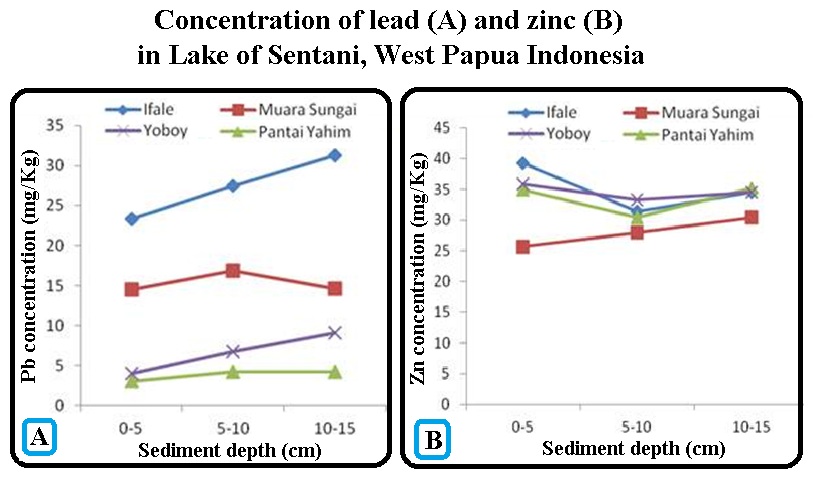The Role of Sedimentation on Waters Edge and Analysis Pb and Zn Concentration in Water from Sentani Lake, Jayapura-Papua
Abstract

We have conducted research on the role of sediment on the waters edge and content analysis of metal concentrations of lead (Pb), zinc (Zn) in the water of Sentani Lake in Jayapura, Papua Province. The experiment was conducted in April 2013. The study was conducted to determine the role of lake sediments on water quality, sediment characteristics and metal analysis has been analyzed in the laboratory to determine the concentration of Pb and Zn in the sediment. Metal analysis using Atomic Absorption Spectrophotometry (AAS) instrumentation. Sediment characteristics that have analysis, namely physical and chemical parameters are bulk density, density, porosity, water content, texture, pH, DO, colors and others. Sediment sampling locations are Ifale, estuary, Yahim beach and Yoboy with each location in depth of 0-5 cm, 5-10 cm and 10-15 cm vertically. The results showed that at each sampling site and every sediment depths showed highly significant influence on the metal content of Pb and Zn. In general, the deeper the sediment content of Pb and Zn showed different results. Average content of heavy metals (Pb and Zn) in sediments at each location that are Ifale at 27.37 mg/Kg and 35.04 mg/Kg, estuary of 15.37 mg/Kg and Pb is 28.01 mg/Kg, Yahim beach of 3.83 mg/Kg and 33.50 mg/Kg, while the location of Yoboy of 6.69 mg/Kg and 34.60 mg/Kg. Concentration of Pb (3.83 to 27.37 mg/Kg) and Zn (6.69 to 35.04 mg/Kg) in sediments is lower than the standard quality of heavy metals in sediments (EPA Region Va) is 40 mg/Kg for Pb and 90 mg/Kg for Zn metals, therefore concentrations of Pb and Zn in sediments at four locations of Sentani lake is still below the quality standard so that the levels of Pb and Zn in the sediment is not contaminated. The existence of Sentani lake sediments act as a reservoir heavy metal and not as a source of pollutants to the water quality in the Sentani lake.
References
Anugerah, Nontji. Lakes And Reservoirs In Indonesia: Their Utilizations And Problems. 1991. Abstract can be accessed online from http://ci.nii.ac.jp/naid/120001087360/] [2] Hutagalung, H. P., & Manik, J. (2002). Kandungan Logam Berat dalam Air dan sedimen di Perairan Muara Sungal Digul dan Arafura. Pesisi r dan Pantai Indonesia VII. P30-UPI. Jakarta. [3] D. W. Connel, Water Pollution Cause and Effects in Australia, University of Queensland Press. Oueensland, 1974. [4] U. Forstner, and F. Prosi, Proceedings of the Course Held at the Joint Research Centre of the Commission of Europian Communities, 1978, ISPRA Pergamon Press, Oxford, p.131. [5] Tokalioǧlu, Ş., Kartal, Ş., and Elci, L. Anal. Chim. Acta, 2000, 413 (1), 33-40. [6] Siaka, M. I, The Application of Atomic Absorption Spectroscopy to the Determination of Selected Trace Element in Sedimen of the Coxs River Catchment, Thesis, Departement of Chemistry, Faculty of Science and Technology, University of Western Sydney Nepean, 1998. [7] Siaka, M. I. Jurnal Kimia, 2008, 2 (2), 61-70 [8] Sukarsa Enco, 2011. Peranan Sedimen Sungai Brantas Hulu Sebagai Inlet Waduk Karangkates Dalam Daur Geokimia Logam Berat Pb, Cu, dan Zn. Tesis. http://elibrary.ub.ac.id/handle/123456789/32826 di akses tanggal 10 November 201
Refbacks
- There are currently no refbacks.









